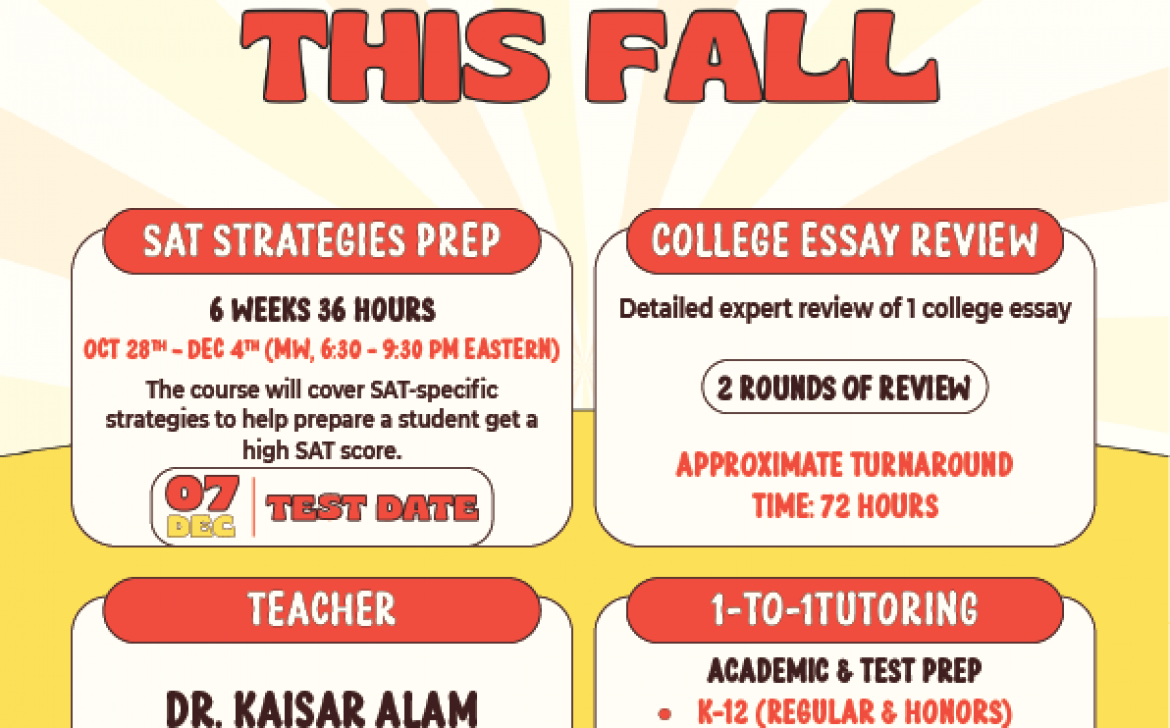Upcoming SAT Dates: Test Dates for 2024-25
Kaisar Alam, Ph.D.
© 2024 Prep Excellence. All rights reserved.
SAT is offered 7 times a year (March, May, June, August, October, November, and December). SAT is generally offered on Saturdays, but if you cannot take the test on a Saturday for a religious reason, Sunday alternate dates are also available. Some school day tests are also given, and your school will generally notify you about them. SAT went digital for the international students in March 2023, but the US students still took the paper-based SAT in 2023. From the March 2024 administration, SAT went digital for everyone.
The table below provides SAT test dates, normal registration deadlines, late registration deadlines, and score release dates for 2024-25. The same dates apply to US and international students. The tests dates are primarily late Spring and in the Fall. This allows juniors to take the test before the summer. The seniors also get multiple chances to hit their score target before their college application deadlines.
| SAT Date | Registration Deadline | Late Registration Deadline* | Score Release |
| August 24, 2024 | August 9, 2024 | August 13, 2024 | September 6, 2024 |
| October 5, 2024 | September 20, 2024 | September 24, 2024 | October 18, 2024 |
| November 2, 2024 | October 18, 2024 | October 22, 2024 | November 15, 2024 |
| December 7, 2024 | November 22, 2024 | November 26, 2024 | December 20, 2024 |
| March 8, 2025 | February 21, 2025 | February 25, 2025 | March 21, 2025 |
| May 3, 2025 | April 18, 2025 | April 22, 2025 | May 16, 2025 |
| June 3, 2025 | May 22, 2025 | May 27, 2025 | July 16, 2025 |
All deadlines are 11:59 PM US Eastern Time.
Any student needing to borrow a device from College Board should register and request their device at least 30 days before test day.
If you need testing accommodations, you must get the accommodations approved by College Board before registering.
- Eligible students should apply at the accommodations website. Approval can take up to 7 weeks.
- Register for the SAT. During registration, confirm that you want to use your accommodation.
- Check that the accommodations are listed on your admission ticket. If they are not correctly listed, call Services for Students with Disabilities for help at 212-713-8333.
Anticipated 2025–26 SAT Test Dates are as follows:
| August 23, 2025 | October 4, 2025 | November 8, 2025 | December 6, 2025 |
| March 14, 2026 | May 2, 2026 | June 6, 2026 |
Registering for the SAT
Begin by signing into your College Board account and going to the registration link is: registration link. The SAT costs $68. International students pay an additional $43. If you don’t know which test center is best for you, you can find the closest centers here. SAT scores are released in approximately 2 weeks, except for the June administration.
Should you take the SAT? Absolutely!
Many colleges dropped the test requirement in response to COVID-19. However, many colleges have since reinstated the testing requirement. These include MIT (US News national rank #2), Havard (#3, tied), Stanford (#3, tied), Yale (#5), Cal Tech (#7), Brown (#9), Cornell (#12), Dartmouth (#18, tied), Vanderbilt (#18, tied), Georgetown (#22, tied), UNC Chapel Hill (#22, tied), University of Florida (Gainesville campus: #28), UT Austin (#32), Georgia Tech (#33), Purdue (#43), University of Wisconsin (#35), and University of Georgia ($47).
Widespread criticisms about testing requirements exist. However, we believe that the problem is not the test itself.
- In fact, SAT (and ACT) scores are a strong predictor of college success, likely because these tests measure skills that are useful in college. A studyfrom Harvard University-based research group Opportunity Insights concludes that standardized test scores can better predict college academic success than high school GPAs, especially at top colleges. High school GPAs do are poor predictors of academic success in college, which might be partly due to the recent widespread grade inflation in high schools. While the study authors did not reject the advantage wealthier students have in standardized testing, they found that low-income students and wealthier students with similar test scores performed similarly in college, with their college GPAs being “virtually identical.”
- Comparing SAT/ACT scores will help college admission officers distinguish between two applicants with similar profiles including GPAs from two school districts. It helps admissions officers differentiate students. In a letter to the Dartmouth community, Dartmouth’s President Sian Leah Beilock wrote, “SAT/ACTs can be especially helpful in identifying students from less-resourced backgrounds who would succeed at Dartmouth but might otherwise be missed in a test-optional environment.”
- Dropping the SAT was hailed by some as a boon to the low-income students. However, MIT’s analysis that led to the reinstatement found that, instead of helping them, dropping the test ended up hurting the disadvantaged students. MIT’s dean of admissions, Stu Schmill, wrote, “Not having SAT/ACT scores to consider tends to raise socioeconomic barriers to demonstrating readiness for our education, relative to having them.” And that the SAT/ACT “help us identify socioeconomically disadvantaged students who lack access to advanced coursework or other enrichment opportunities that would otherwise demonstrate their readiness for MIT.”
- Contrary to conventional wisdom, test optional policies might make it more difficult to get admitted to the top colleges. The class of 2023 (2019 freshman class) was the first test-optional class for University of Chicago, but their admission rate dropped 1.3% (7.2% to 5.9%). The number of applications went from 32,291 applicants to just under 35,000 applications. Even more interesting, the average test score increased 15 points!
It is important to understand that even for test-optional colleges, college admission tests still play an important role. Despite the test-optional policies, 2.2 million students still took the SAT from high school class that graduated in 2020. The numbers were 1.5 million in 2021, 1.7 million in 2022, and 1.9 million in 2023. Clearly, most applicants are still submitting test scores to test optional schools. You can submit a great score to enhance your application!
If you receive a good score for the college (top 25% for the college) or a 99th percentile SAT score (currently 1520), my personal advice is to submit it and give yourself an advantage. A good score can also improve your chances of receiving a merit scholarship in colleges that offer them (even for test-optional colleges).
ACT Deadlines 2024-25
ACT is the other college admission test. Much of the information discussed above apply to ACT. Colleges in the US accept both tests and do not prefer one test over the other. The table below provides ACT test dates and the associated deadlines.
| ACT Date | Registration Deadline | Late Registration Deadline* | Photo Upload and Standby Deadline |
| September 14, 2024 | August 9, 2024 | August 25, 2024 | September 6, 2024 |
| October 26, 2024 | September 20, 2024 | October 7, 2024 | October 18, 2024 |
| December 14, 2024 | November 8, 2024 | November 22, 2024 | December 6, 2024 |
| February 8, 2025 | January 3, 2025 | January 20, 2025 | January 31, 2025 |
| April 5, 2025 | February 28, 2025 | March 16, 2025 | March 28, 2025 |
| June 14, 2025 | May 9, 2025 | May 26, 2025 | June 6, 2025 |
| July 12, 2025* | June 6, 2025 | June 20, 2025 | July 4, 2025 |
*No test centers are scheduled in New York for the July test date.
SAT/ACT Test Prep
It’s never too early to start preparing for the SAT and ACT. If you need help with your test preparation, please check out our blog and YouTube channel. Prep Excellence offers several industry-leading test prep courses and top SAT and ACT tutoring that you can take advantage of.





